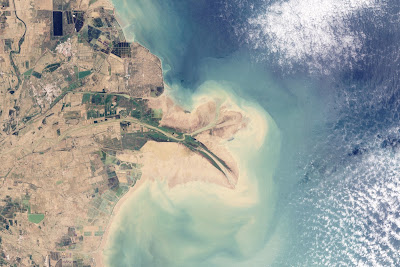- River Delta formed by;
Deposition of the sediment at the mouth of a river.
- River flows into;
ocean
sea
estuary
lake
reservoir
 |
| The Ganges Delta, India |
- Obtaining a more stable steeper slope.
- Depositional processes force redistribution of deposition from areas of high deposition to areas of low deposition.
-examples of avulse : the Mississippi and Ural River deltas
- Deltas are classified to the main control on deposition.
- which is usually either a river, waves, or tides.
1.wave dominated deltas.
Wave erosion controls the shape of the delta.
River mouth is deflected along the coast line.
Deltas of this form, such as the Nile Delta.
 |
| Ganges Delta |
2.Erosion /tide dominated deltas.
Mainly submarine.
Prominent sand bars and ridges.
Produce a "dendritic" structure.
Differently from river- & wave-dominated deltas
It is abandoned.
3.A Gilbert delta
Formed by coarse sediments.
Opposed to gently-sloping muddy deltas.
Mountain river depositing sediment into a freshwater lake
Located on coasts tidal range
4.Inverted river delta.
Located inside a large valley.
Divide into multiple branches in an inland area.
Only to rejoin and continue to the sea.
Often occur on former lake beds.
Divide into multiple branches in an inland area.
Only to rejoin and continue to the sea.
Often occur on former lake beds.
examples
Inner Niger Delta.
Peace–Athabasca Delta .
Okavango Delta in Botswanais.
 |
| Okavango Delta |
5.Alluvial fans
Deltas have a shallow slope.
Contain fine-grained sediment;
sand & mud
Flow into a body of water.
- The most famous delta is the Nile River.
- The Ganges/Brahmaputra is the world's largest delta.
- Notable deltas include ;
Fly River Cauvery Niger River
Tigris-Euphrates Rhine Po
Rhône Danube Ebro
Volga Lena Indus
Ayeyarwady Mekong Huanghe
Yangtze Sacramento-San Joaquin Mississippi
Orinoco Paraná
 |
| Mississippi River Delta |
 |
| Yellow delta |


.jpg)


No comments:
Post a Comment